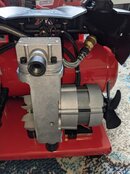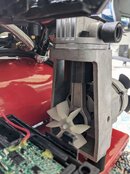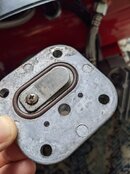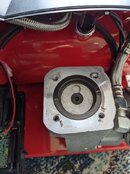mr.jadkowski
Registered
I'm going to jump into the discussion to document my own DIY hookah build.
I'm primarily a shallow-water, fresh water freediver, but it's hard to find dive buddies where I live and even when I do the visibility is so bad that below 15 feet you can't see another diver from the surface. I would like to build something with similar capability to the Blu3 NOMAD or the AirBuddy, just with less cost. Harbor Freight now sells a brushless, cordless compressor that, on paper, should have the capability for one diver at 1ATM. As far as I know it hasn't been used in a hookah system, except for one dude on YouTube who used it in his pool, so I bought one to test.
To get to the point where I can use this to dive from a dock or my boat, to test the capabilities of the compressor, I ordered:
Cheapo regulator and breathing hose
.3 micron filter
I've read through this thread a couple of times and have seen all the warnings about rust in the tank, teflon particulate from oilless piston pumps, residual oil in hoses from manufacturing, securing the air line to a weight belt or harness, and all the standard safety precautions for compressed air diving. I still have yet to completely tear down the compressor, but from what I can see it looks like a teflon-lined, oilless piston pump and the tank is definitely steel. In order to mitigate some of the risks from using this non-ideal compressor setup, this is what I have done and plan to do:
If this thing actually works like I hope it will, I plan on putting it in a floating enclosure with a snorkel intake so I can dive away from the boat. I did a quick test running the compressor continuously with the maximum amount of flow that it could handle and still maintain the tank at 40 PSI, and one battery lasted 13 minutes. It doesn't seem totally unreasonable that two batteries could last 30 minutes if the compressor isn't running at maximum flow all the time.
I'm primarily a shallow-water, fresh water freediver, but it's hard to find dive buddies where I live and even when I do the visibility is so bad that below 15 feet you can't see another diver from the surface. I would like to build something with similar capability to the Blu3 NOMAD or the AirBuddy, just with less cost. Harbor Freight now sells a brushless, cordless compressor that, on paper, should have the capability for one diver at 1ATM. As far as I know it hasn't been used in a hookah system, except for one dude on YouTube who used it in his pool, so I bought one to test.
To get to the point where I can use this to dive from a dock or my boat, to test the capabilities of the compressor, I ordered:
Cheapo regulator and breathing hose
.3 micron filter
I've read through this thread a couple of times and have seen all the warnings about rust in the tank, teflon particulate from oilless piston pumps, residual oil in hoses from manufacturing, securing the air line to a weight belt or harness, and all the standard safety precautions for compressed air diving. I still have yet to completely tear down the compressor, but from what I can see it looks like a teflon-lined, oilless piston pump and the tank is definitely steel. In order to mitigate some of the risks from using this non-ideal compressor setup, this is what I have done and plan to do:
- 30 minute compressor break-in (as recommended in the manual) - done
- Washed the inside of the compressor tank with 13:1 hot water:simple green - done
- Rinsed the inside of the compressor tank with hot water 2x - done
- Flush the breathing hose and regulator hose with 13:1 hot water:simple green
- Rinse the breathing and regulator hoses with hot water 2x
- Install .3 micron coalescing filter between the compressor and breathing hose
- Set the outlet air pressure to the lowest pressure I can tune the regulator to
- Do some incremental testing with increasing depth and dive times with a commercial diver buddy
- Not dive any deeper or longer than I can safely do a free-swimming ascent without a safety stop
- Drain the tank after every dive and leave the drain valve open to prevent moisture build-up
- Stop diving with the compressor once the tank starts to rust
If this thing actually works like I hope it will, I plan on putting it in a floating enclosure with a snorkel intake so I can dive away from the boat. I did a quick test running the compressor continuously with the maximum amount of flow that it could handle and still maintain the tank at 40 PSI, and one battery lasted 13 minutes. It doesn't seem totally unreasonable that two batteries could last 30 minutes if the compressor isn't running at maximum flow all the time.







